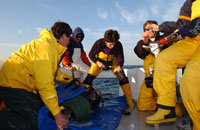TAG Scientist Dr. Rebecca Whitlock's account of the International Scientific Committee for Tuna and Tuna-like species in the North Pacific Ocean (ISC) Pacific Bluefin Working Group Workshop held in Shimizu, Japan, January 6-13, 2011:
Scientists representing the U.S.A., Japan, Taiwan and the IATTC (Inter-American Tropical Tuna Commission) gathered in Shimizu, Japan in January to discuss improvement of the assessment model that is used to evaluate stock status and estimate fishing mortality rates for bluefin tuna in the Pacific Ocean. Shimizu is a city in the Shizuoka prefecture on Japan’s east coast, with spectacular views of Mount Fuji. It is also home to the country’s leading tuna landing fishing port. Our hosts showed great hospitality, laying on two dinners, one of traditional Japanese fare for attendees, in addition to organizing a karaoke session for us in Shizuoka!
The meeting dealt with issues including maintaining and improving the quality of input data, how best to incorporate new data into the assessment, whether and how spatial structure should be included in the model, the appropriate way to model the relationship between the abundance/mass of spawning fish in the population and new recruits, and new estimates of biological parameters used in the model, such as the rate of natural mortality. I attended the meeting on behalf of the Block lab at Stanford University and Tag-A-Giant, to present findings from an analysis of an archival tagging dataset for tagged Pacific bluefin tuna released in the east Pacific Ocean. Archival tags are returned to the lab when tagged tuna are captured by fisheries. Using the location and date of recapture plus release, this allows inference about rates of movement and natural and fishing mortality for tagged bluefin tuna. Estimated harvest rates from my analysis were generally higher than existing estimates from the stock assessment, and the natural mortality rate for older fish was lower than that currently assumed in the assessment model. The updated estimate of the natural mortality rate proved especially controversial; the rate of natural mortality is fundamental to population dynamics, essentially determining the productivity of the modeled stock. The workshop culminated in a report summarizing the presentations and related discussions. However, consensus on some of the more important issues surrounding Pacific bluefin biology, including rates of natural mortality, proved unattainable.
The search for bluefin tuna is on! A team of scientists from Stanford University and other partner institutions is scouring waters in both the Atlantic and Pacific oceans. The goal - to place electronic tags in giant bluefin tuna to learn more about their migrations, behavior, and environmental preferences. Read about their adventures below...




No comments:
Post a Comment